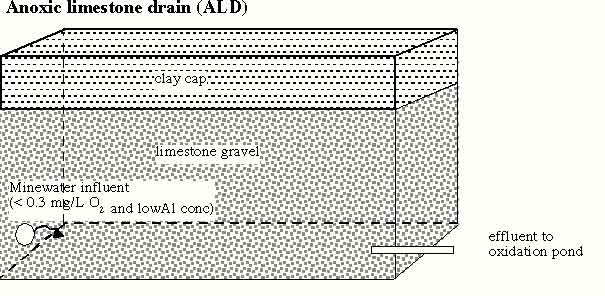
Diagram courtesy of Carl S. Kirby, Bucknell University
So far, BAMR has completed construction on two separate
facilities using anoxic limestone drains
(ALD’s) and has partially funded a third site. The first was constructed
on Cucumber Run in Fayette County, primarily within Ohiopyle State Park.
This was a rehabilitation of a facility constructed under Operation
Scarlift. Flows from two separate sources were directed into ALD’s
prior to being discharged into an existing aerobic
wetland. This facility has been operating since 1997 and has been the
most maintenance free facility to date. The ALD’s were of a somewhat
unique construction to address aluminum levels in the raw water that
became elevated during the latter phases of design of this project.
The ALD’s were teardrop shaped, with the widest portion being on
the upslope end near the source, and were oversized. They were constructed
on relatively steep slopes, rather than the usual, nearly level construction,
and clay barriers were placed within the drains to help keep more of
the drain flooded. While both drains have air seals at the outlet, neither
is entirely flooded, so some air is present in the drains. These drains
are likely retaining some aluminum, although they were not constructed
with sampling ports at the head of the drains, so we are unable to monitor
raw water quality. However, no aluminum is discharging from the drains,
so it is likely they are retaining aluminum. While only time will tell
for sure how effective this design has been in preventing plugging by
aluminum, so far the results have been good. Other ALD’s are known
to have plugged from aluminum within months of construction, so this
design has shown promise in its operation. Cucumber Falls, a popular
tourist attraction downstream of DEP’s system, has improved aesthetically
(no iron staining) since the system has been in operation. A macroinvertebrate
survey has also shown considerable improvement in Cucumber Run.
A second ALD system has been constructed by BAMR on a site where bonds
were forfeited along Glade Run in Armstrong County. This site, known
as Darmac 14, was completed in the fall of 1998. Prior to construction
of BAMR’s facilities, a limestone trench constructed by the former
coal operator was intercepting and collecting AMD emanating from a reclaimed
surface mine site. Sampling of a small discharge not being intercepted
indicated a net alkaline discharge with elevated iron and manganese
concentrations. The flow from the trench was directed into an ALD during
construction. The discharge from the ALD then enters a settling pond/aerobic
wetland.
The decision to install an ALD was made for several reasons, in spite
of the apparent net alkaline conditions. There was concern that some
of the water being intercepted by the limestone trench may be net acidic
prior to the contact with the limestone, and there was concern about
the longevity of the trench as it was currently constructed – how
long it would take to deplete or armor the limestone in an open channel
(U. S. Bureau of Mines, 1995). While there were problems in construction
attempting to capture all the flow, post-construction stream data indicates
that this was largely successful. The treatment system has been operating
very effectively, with a strongly net alkaline discharge and low metals
concentrations.
An ALD system that was partially funded but not constructed by BAMR
has had considerable problems with aluminum. This project, known as
the Conifer project, was constructed along Beaver Run in Jefferson County.
A year of background sampling showed aluminum in the range of 2 mg/L.
In order to prevent plugging of the drain, the ALD was designed with
a perforated manifold system to spread the flow over a large surface
area at the inlet, and a relatively wide drain was constructed (80’
wide by 250’ long [24.3 m by 76 m]). The system was completed in
the fall of 1998. Later that year a drought caused the deep mine discharge
to dry up completely. When the flow came back in early 1999, aluminum
levels had increased considerably and have stayed much higher than was
previously measured. The ALD plugged soon after the flow came back.
Fortunately, the design of the system allowed for access to the inlet
of the ALD, where flows could be backed up in the mine using a water
level control structure, and a pump was used to “backwash”
the ALD. This, and the resultant flushing when the drainage was directed
back into the drain, allowed the drain to function for about six months.
After that time period, the process needed to be repeated. Subsequent
backwashing and flushing has resulted in decreasing time periods until
the ALD plugs again. Recently, a decision was made to excavate the inlet
portion of the ALD to determine the location of the plugging. If it
is found that all the plugging is occurring within the first few inches
of the drain, the manifold will be removed and replaced by a pipe to
concentrate a higher velocity flow over a smaller area to see if this
corrects the plugging problem (Hein, 2000).


Return
to AMD Stakeholders' page
